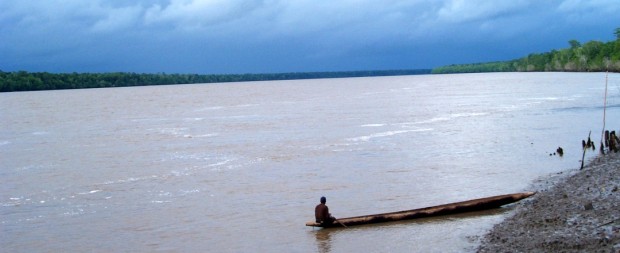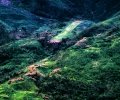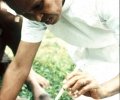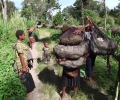Dugouting
In order to survive in the interior of Papua, we have to have a special motivation. Money did not work for me; my salary was very little and I had come not for it. Helping people, honestly, was not an adequate drive when I had malaria and I was disappointed with the attitude of these people in returning my service. Exploring the pristine nature, taking photographs, and researching tropical diseases worked well.
I bought a small dugout for 35,000 rupiah (~$15) and painted it blue by myself. The painting cost me around 50,000, more the dugout price. It could carry three passengers.
Every Sunday morning, when most women and some men at church, I went to the mouth of Kronkel River with my dugout. Mono, my adopted boy, sometimes with his older brother, came with me. I could not row the dugout by myself—something a 4-year old Asmat boy could do easily. I had tried hard, but the dugout always fell upside down. As I did not swim well, this always made me panicked.
We cruised under the mangrove—it stretches hundreds of kilometers from Mimika to Merauke—and I took photographs anything alive around us. There were many beautiful, some very funny, creatures. My most favorite was fiddler crabs—‘it is only the male fiddler crab that has one claw significantly larger than the other. The male uses it to court females. If for some reason the larger claw is lost, the remaining smaller claw will grow larger and the lost claw re-grows as the smaller one! Fiddler crabs can’t swim!’ [Wikipedia] I enjoyed looking at them digging holes, ‘fanning’ water with their big claw over and over into their mouths—I bet that was the way they ate— scampering about randomly, chasing each other, and rushing into one hole when they noticed my watching them and then come out of another hole.
The second favorite was mudskipper. ‘Mudskippers are gobies that have become adapted to an amphibious lifestyle. Mudskippers range in size from 6 to 10 inches. Beneath the surface of the water, the Mudskipper digs mudflat burrows that are used for refuge and spawning.’ [Wikipedia] They looked like tadpoles, but much bigger. Their large eyes are on top their heads. Tail is used for moving on either mud or mangrove roots by wagging it. Just amazing to see how far they could jump when they are surprised: the distance is about 10 to 12 times of their body length.
Egrets—clean and bright white feathered—standing motionlessly either on the roots of mangroves or in the water with their long legs and quickly snapping their prey with their long, sharp beaks before flying elegantly was a never boring view along the river banks.
If I did not use it, I parked the dugout by the beach at the path into the complex. Sometimes it was gone and came back when I asked about it to the people in the village. It was ‘borrowed’ by the family who had no dugout for collecting sago in the jungle. Logs were abundant, but men were very lazy to make dugouts. My lovely dugout finally was gone forever when I went to Merauke for a meeting.





